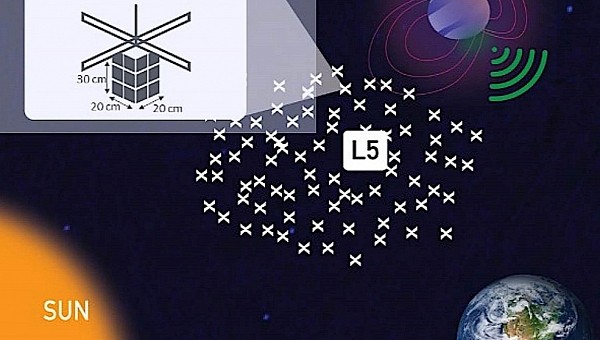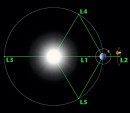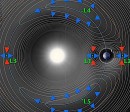When it comes to space exploration, sending spacecraft with various technologies to touch or almost touch alien worlds is NOT the main method used. That may seem a bit counterintuitive, especially now, with so many rocket launches taking place, but it’s true.
Since long before we were technologically advanced enough to send spacecraft into space, humans have used all sorts of optical, radio, and related devices to look at the skies and the wonders out there. We still do it, with both Earth- and space-based telescopes helping us unlock the mysteries of the Universe.
There are still limitations to what we can do, though. Despite the many wonderful images and data coming our way thanks to pieces of hardware as the likes of the James Webb Space Telescope (JWST), we’re still incapable of looking at “the low-frequency radio sky,” as scientists call it.
That would be frequencies between 100 kHz and 15 MHz, used by space to tell us stuff about itself through something called electromagnetic radiation. We’re presently not that well equipped to capture it, as telescopes on Earth can’t pick it up on account of the ionosphere, while space-based ones like the JWST would need to be a hell of a lot larger to be capable of the task.
Electromagnetic radiation is important for scientists as it may carry with it info about the magnetic fields of both stars and exoplanets, and as most of you already know, a magnetic field around a planet is essential for the existence of life as we know it. Separately, this kind of radiation can also help us better understand more about early stars and galaxies.
How can we get access to all this info, then? Researcher Mary Knapp from the Massachusetts Institute of Technology (MIT) believes an answer could be found in the tiny pieces of hardware we call SmallSats.
Increasingly used in recent years along with their siblings the CubeSats, they could form a massive network of satellites, a constellation, if you like, and would function as a single telescope, eliminating the need for massive builds to capture low-frequency signals.
How massive? Think thousands of them, deployed deep in space in an area called Lagrange point L5 – these points, five of them in our solar system, are places where the gravity nearby planets and the Sun cancel each other out, allowing hardware to float there virtually forever.
The satellites are to use a new piece of technology called Vector Sensor Antenna (VSA), which will target precisely the low-frequency we need to study, and a technique called interferometry to bind together all the individual signals of each SmallSat and form a coherent picture of what’s out there. It could look at exoplanets located as far as five parsecs from Earth (a parsec is 3.26 light years).
Aside from acting like a huge telescope without being one, the constellation would have several other advantages. First up, if a SmallSat malfunctions, it could easily be replaced, and it would be cheap to do so. By extension, if one fails and cannot be replaced, it shouldn’t affect the functionality and capabilities of the others. Then, building SmallSats for this task would not be incredibly complex, as neither are their instruments.
Knapp’s constellation is called Great Observatory for Long Wavelengths, or GO-LoW, and, for now, it is just an idea on a piece of paper. A worthy-enough one, having been awarded a NASA Innovative Advanced Concepts (NIAC) Phase 1 grant earlier in January, but too early to tell if anyone will pick it up and make it a reality.
There are still limitations to what we can do, though. Despite the many wonderful images and data coming our way thanks to pieces of hardware as the likes of the James Webb Space Telescope (JWST), we’re still incapable of looking at “the low-frequency radio sky,” as scientists call it.
That would be frequencies between 100 kHz and 15 MHz, used by space to tell us stuff about itself through something called electromagnetic radiation. We’re presently not that well equipped to capture it, as telescopes on Earth can’t pick it up on account of the ionosphere, while space-based ones like the JWST would need to be a hell of a lot larger to be capable of the task.
Electromagnetic radiation is important for scientists as it may carry with it info about the magnetic fields of both stars and exoplanets, and as most of you already know, a magnetic field around a planet is essential for the existence of life as we know it. Separately, this kind of radiation can also help us better understand more about early stars and galaxies.
How can we get access to all this info, then? Researcher Mary Knapp from the Massachusetts Institute of Technology (MIT) believes an answer could be found in the tiny pieces of hardware we call SmallSats.
Increasingly used in recent years along with their siblings the CubeSats, they could form a massive network of satellites, a constellation, if you like, and would function as a single telescope, eliminating the need for massive builds to capture low-frequency signals.
How massive? Think thousands of them, deployed deep in space in an area called Lagrange point L5 – these points, five of them in our solar system, are places where the gravity nearby planets and the Sun cancel each other out, allowing hardware to float there virtually forever.
The satellites are to use a new piece of technology called Vector Sensor Antenna (VSA), which will target precisely the low-frequency we need to study, and a technique called interferometry to bind together all the individual signals of each SmallSat and form a coherent picture of what’s out there. It could look at exoplanets located as far as five parsecs from Earth (a parsec is 3.26 light years).
Aside from acting like a huge telescope without being one, the constellation would have several other advantages. First up, if a SmallSat malfunctions, it could easily be replaced, and it would be cheap to do so. By extension, if one fails and cannot be replaced, it shouldn’t affect the functionality and capabilities of the others. Then, building SmallSats for this task would not be incredibly complex, as neither are their instruments.
Knapp’s constellation is called Great Observatory for Long Wavelengths, or GO-LoW, and, for now, it is just an idea on a piece of paper. A worthy-enough one, having been awarded a NASA Innovative Advanced Concepts (NIAC) Phase 1 grant earlier in January, but too early to tell if anyone will pick it up and make it a reality.






